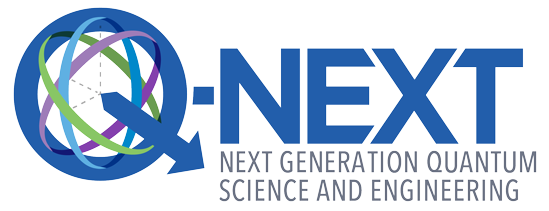Science and Technology
Q-NEXT advances QIS by tackling one of the most prominent challenges facing the field: manipulating and connecting entangled states of matter. Q-NEXT is developing technologies that can control, store and transmit entangled quantum information at distances that could be as small as a computer chip or as large as the distance between Chicago and San Francisco.
Entanglement is a special, powerful correlation between quantum particles available only at nature’s smallest scales. It occurs when two or more particles are inseparably correlated. When one makes a measurement of one particle in an entangled pair, one gains information about both. This is true no matter how much physical distance separates them.
Sharing and transferring entangled states of matter requires devices that can mediate between different mediums, devices, systems or physical states. The delivery of these quantum interconnects, as these mediating technologies, are called, will enable future secure communication links, quantum sensor networks, and simulation and network test beds.
Q-NEXT is working to develop interconnects by developing new quantum materials and integrating them into devices and systems, developing new classes of ultraprecise sensors, and overcoming losses that occur when quantum information is communicated over long distances. The center also developing simulation and characterization tools that can be applied to these quantum systems.
To achieve its mission, Q-NEXT’s strategy is to pursue three foundational research areas (quantum foundries, extreme-scale characterization, and quantum simulation and sensing) with three science and technology areas (materials and integration, quantum sensing, and quantum communications).
Research that comes out of Q-NEXT could transform how we live our everyday lives, from faster drug delivery to unhackable communication networks.
Q-NEXT’s pioneering research focuses on six R&D areas:
Quantum foundries
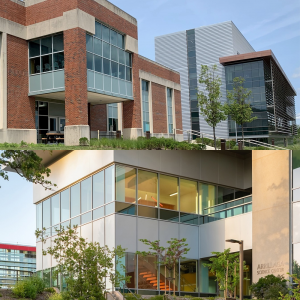 Q-NEXT institutions are building quantum foundries that will serve as a national resource for quantum information science. Based at Argonne National Laboratory and SLAC National Accelerator Laboratory, the two foundries will provide a robust supply chain of high-quality, standardized materials and devices for quantum applications. The Argonne Quantum Foundry will focus on semiconductor technology, and the SLAC Detector Microfabrication Facility will focus on superconducting devices. As in-demand sources of quantum materials and data, the foundries will help accelerate national and global research in quantum information science. Learn more.
Q-NEXT institutions are building quantum foundries that will serve as a national resource for quantum information science. Based at Argonne National Laboratory and SLAC National Accelerator Laboratory, the two foundries will provide a robust supply chain of high-quality, standardized materials and devices for quantum applications. The Argonne Quantum Foundry will focus on semiconductor technology, and the SLAC Detector Microfabrication Facility will focus on superconducting devices. As in-demand sources of quantum materials and data, the foundries will help accelerate national and global research in quantum information science. Learn more.
Extreme-scale characterization
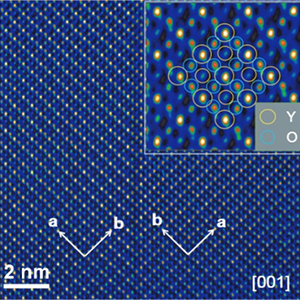 Qubits — the basic unit of quantum information — can be made from a variety of materials and vary widely in how well they receive, store, and transmit information. By imaging qubit structures and characterizing their behavior under different conditions with extreme precision — down to billionths of a millimeter and million-millionths of a second — Q-NEXT scientists learn how the qubits’ atomic-scale properties influence their performance. Their improved understanding enables Q-NEXT to develop new qubits and quantum systems optimized for a wide span of applications.
Qubits — the basic unit of quantum information — can be made from a variety of materials and vary widely in how well they receive, store, and transmit information. By imaging qubit structures and characterizing their behavior under different conditions with extreme precision — down to billionths of a millimeter and million-millionths of a second — Q-NEXT scientists learn how the qubits’ atomic-scale properties influence their performance. Their improved understanding enables Q-NEXT to develop new qubits and quantum systems optimized for a wide span of applications.
Quantum simulations and systems
 Scientists simulate the behavior of quantum devices and systems to predict their properties and improve their ability to control and scale them. To that end, Q-NEXT scientists are developing open-source simulation tools that model quantum materials and systems. They are using quantum computers and traditional supercomputers to study the behavior of quantum materials, algorithms, and devices that operate using multiple qubits. Q-NEXT is also developing the first US-based quantum network simulator. Together, Q-NEXT academic and industry partners are building and optimizing qubit test beds.
Scientists simulate the behavior of quantum devices and systems to predict their properties and improve their ability to control and scale them. To that end, Q-NEXT scientists are developing open-source simulation tools that model quantum materials and systems. They are using quantum computers and traditional supercomputers to study the behavior of quantum materials, algorithms, and devices that operate using multiple qubits. Q-NEXT is also developing the first US-based quantum network simulator. Together, Q-NEXT academic and industry partners are building and optimizing qubit test beds.
Materials and integration
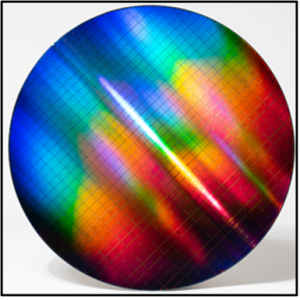
The creation of next-generation materials for building qubits — the basic unit of quantum information — is foundational to the Q-NEXT program. Q-NEXT scientists and engineers are fabricating novel materials, including at the two foundries and partner companies, evaluate and refine them, and integrate them into quantum devices. These include qubits and quantum memories, analogous to the memory on your desktop computer. The memories will be used in devices called quantum repeaters, which sustain a signal over long distances. Device integration is key: A high-performing, bare qubit must maintain an excellent level of performance once it is installed as part of a larger system. In developing these materials and integration methods, Q-NEXT is helping ensure superior technologies for quantum science.
Quantum communication
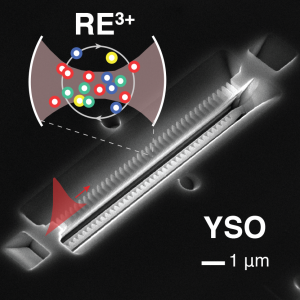 To communicate quantum information over long distances, researchers exploit a property called “quantum entanglement.” When two particles are entangled, their properties are inseparably linked, no matter how much distance lies between them. Knowing the properties of one particle in an entangled pair gives all the information one needs to understand the state of its partner — without having to observe it directly. Q-NEXT researchers are developing the technology to build optical-fiber networks that transmit signals in the form of entangled states. Since the signal inevitably weakens as it travels, the networks require quantum repeaters at periodic intervals, devices that repeatedly “stitch” the signal back together so it can be transmitted at full strength. Q-NEXT’s goal is to connect distant nodes with repeater-enabled links.
To communicate quantum information over long distances, researchers exploit a property called “quantum entanglement.” When two particles are entangled, their properties are inseparably linked, no matter how much distance lies between them. Knowing the properties of one particle in an entangled pair gives all the information one needs to understand the state of its partner — without having to observe it directly. Q-NEXT researchers are developing the technology to build optical-fiber networks that transmit signals in the form of entangled states. Since the signal inevitably weakens as it travels, the networks require quantum repeaters at periodic intervals, devices that repeatedly “stitch” the signal back together so it can be transmitted at full strength. Q-NEXT’s goal is to connect distant nodes with repeater-enabled links.
Quantum sensing
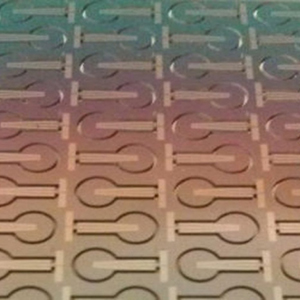 Q-NEXT is developing instruments that detect signals with unprecedented sensitivity. These include as devices that pick up electromagnetic signals one photon (particle of light) at a time or measure them with accuracy even below the standard quantum limit of detection. This is accomplished through the phenomena of quantum squeezing (a method that reduces measurement uncertainty) and entanglement (a quantum phenomenon in which two signals are informationally inseparable). To meet the challenge, Q-NEXT scientists are creating new algorithms for measuring signals based on innovations in quantum science, expanding capabilities to sense photons over a wide range of frequencies, and innovating ways to integrate sensors into larger quantum systems. Breakthroughs in quantum sensing will lead to quantum systems that far outperform the current state of the art.
Q-NEXT is developing instruments that detect signals with unprecedented sensitivity. These include as devices that pick up electromagnetic signals one photon (particle of light) at a time or measure them with accuracy even below the standard quantum limit of detection. This is accomplished through the phenomena of quantum squeezing (a method that reduces measurement uncertainty) and entanglement (a quantum phenomenon in which two signals are informationally inseparable). To meet the challenge, Q-NEXT scientists are creating new algorithms for measuring signals based on innovations in quantum science, expanding capabilities to sense photons over a wide range of frequencies, and innovating ways to integrate sensors into larger quantum systems. Breakthroughs in quantum sensing will lead to quantum systems that far outperform the current state of the art.
